
Hunting for energy efficiency within electronic designs
By Aury Hathout M.Env, certified environmental auditor, Enviropass Expertise, Montreal
Power Supply / Management Environmental energy efficiencySince the miraculous entrance of electricity into our homes in the early 20th century, electrical devices gradually became part of our daily life. Nowadays, who can imagine living without electricity? We use it for almost everything: lighting, phoning, cooking, cooling computing, printing, ironing, vacuuming, shaving and even for brushing, reading, biking or driving etc.
The IEA (International Energy Agency) reports that 15% of residential electricity consumption is now spent in consumer electronics and computer equipment and this consumption is exponentially increasing (https://www.iea.org/aboutus/faqs/energyefficiency).
Electronics can help save energy
Furthermore, electronic devices not only use energy for their main function. They also require energy for their development, production, assembly, sale and transportation. However, electronics can also help us save energy, for example when we place orders online or use our GPS (Global Positioning System) for navigation etc. Therefore, ones may be wondering: what is the overall role of electronics in global energy consumption?
Following the COP21 (Conference of the Parties), which took place last December in Paris, a universal climate agreement was approved by most countries. The objective of this agreement was to limit the global temperature increase to a maximum of two-degrees overall and possibly even 1.5-degrees by the end of the century. Practically, this means drastically reducing the use of oil, coal and natural gas in energy production, which are responsible for emission of greenhouse gases. Here in Canada, the goal is to reduce emissions 30% below 2005 levels by 2030.
Questions remain
The question is: how can humanity achieve this significant reduction in temperature and develop a decarbonized economy? The present solution lies in finding alternative sources of energy, such as nuclear or green energies (solar, wind, geothermal energies or others) while improving the current energy efficiency rate… and more specifically the energy efficiency of electronic devices.
Several standards and regulations are already in place in the world, which have lead to better energy efficiency of household appliances. For example, the European Union has set eco-design rules to improve the energy consumption of 40 types of products, such as water heaters, televisions, refrigerators, lightning etc. European regulations also take into account the standby mode and other energy modes, as well as eco-labeling requirements. In North America, similar programs like Energy Star have also provided significant improvement in energy efficiency of electrical and electronic products.
Starting on February 10th of this year in the USA, external power supplies must comply with the energy efficiency level VI requirement. Therefore, lower energy efficiency levels can no longer be placed into the US market. Having the power supply marked by the Roman numeral ‘VI’ indicates compliance to this requirement. According to the US DoE (Department of Energy), the application of level VI would result ‘in cumulative emissions reductions of 23.6 Mt (million metric tons) of CO2’ through 2030 and in savings of up to $ 3.8-billion over the next 30 years (source: Department of Energy, 10 CFR Part 430, Docket No. EERE–2008–BT–STD–0005, p. 11).
IoT an energy saver?
While the emergence of the Internet of Things (IoT) requires improvement in energy efficiency, it also provides fantastic new energy savings opportunities. Thanks to the IoT, innovations for smart transportation and buildings will lead to energy efficient solutions. Can you imagine ‘smart traffic lights’ designed to turn green when no other car is crossing in the intersection? Think about the great savings in greenhouse gas emissions, money, time and… headache! Regarding buildings, the European Union is taking the lead by fostering energy management improvement by making periodical buildings energy audits obligatory. These current actions are only baby steps towards smart cities and ultimately a smart planet, in a not so distant future.
Besides energy consumption, electronics have additional impacts on the environment. Some regulations consist in controlling certain chemicals from the product design stage. Examples include the ‘Restriction of Hazardous Substances’ (RoHS) in electronics, bans of hazardous materials in batteries and the monitoring of ‘Substances of Very High Concern’ (SVHC) according to the ‘Registration, Evaluation, Authorization and Restriction of Chemicals’ (REACH) regulation. Of significant importance is the coming expiration of European RoHS exemptions on July 21st of this year. Therefore, if some of the components used in your products assemblies benefit from any of these exemptions, monitoring and replacing of these components is necessary. Other regulations target the ‘Waste Electrical and Electronic Equipment’ (WEEE) and its management. Finally, several socio-environmental laws are intended to ban modern labor slavery. Others, like the US ‘Dodd-Frank Act’, ban the supply of Conflict Minerals – such as tin, tantalum, tungsten or gold – under control of terrorist groups.
OEMs watchful of energy efficiency
Manufacturers of electronic products now have to address the impact of energy efficiency, choice of materials, waste management and social responsibilities. It is important to note that these regulations and standards that govern the electronic industry are here to stay and tend to cover more and more impacts in a more complete way. For the manufacturer’s point of view, all of these new environmental regulations may be considered as complex, costly or even an unfair burden. However, when monitored and integrated into day-to-day corporate procedures, these regulations can also become a tremendous catalyst for innovation and competitiveness. The question is: will you consider them a threat or a good opportunity?

